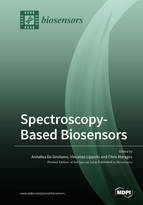Spectroscopy-Based Biosensors
A special issue of Biosensors (ISSN 2079-6374).
Deadline for manuscript submissions: closed (31 August 2019) | Viewed by 54608
Special Issue Editors
Interests: food quality; food safety; food authenticity; infrared spectroscopy; rapid methods; chromatographic methods; methods validation; chemometric analysis
Special Issues, Collections and Topics in MDPI journals
Interests: fluorescence polarization spectroscopy; chromatographic methods; rapid/innovative methods; method development and validation; food quality/safety/authenticity
Special Issues, Collections and Topics in MDPI journals
Interests: biosensor; immunosensor; biolayer interferometry; fluorescence polarization; surface plasmon resonance; ambient ionization mass spectrometry; antibodies; aptamers; imprinted polymers; natural toxins; commodities; food; feed
Special Issue Information
Dear Colleagues,
Biosensors represent a growing analytical tool with a wide field of application. Compactness, portability, high specificity, and sensitivity are some reasons why biosensors are considered to have a high potential for replacing current analytical practices. Among biosensors, those based on spectroscopy represent the major group and display features that can make them advantageous over other biosensor devices. Some examples of spectroscopic-based biosensors include absorption spectroscopy, Raman and conventional fluorescence spectroscopy, imaging, surface plasmon resonance, evanescent wave and infrared spectroscopy, fiber optic spectroscopy, luminescence, fluorescence polarization and energy transfer. Antibodies, aptamers, peptides or bio-mimetic recognition elements, are some examples of biorecognition elements for target molecule detection.
The Biosensors Special Issue “Spectroscopy-Based Biosensors” is intended to be a timely and comprehensive issue on very recent and emerging biosensor concepts and technologies. Papers with applications in food will be also highly appreciated.
We cordially invite you to submit research papers, short communications and reviews to share your work with our readers.
Dr. Annalisa De Girolamo
Dr. Vincenzo Lippolis
Dr. Chris Maragos
Guest Editors
Manuscript Submission Information
Manuscripts should be submitted online at www.mdpi.com by registering and logging in to this website. Once you are registered, click here to go to the submission form. Manuscripts can be submitted until the deadline. All submissions that pass pre-check are peer-reviewed. Accepted papers will be published continuously in the journal (as soon as accepted) and will be listed together on the special issue website. Research articles, review articles as well as short communications are invited. For planned papers, a title and short abstract (about 100 words) can be sent to the Editorial Office for announcement on this website.
Submitted manuscripts should not have been published previously, nor be under consideration for publication elsewhere (except conference proceedings papers). All manuscripts are thoroughly refereed through a single-blind peer-review process. A guide for authors and other relevant information for submission of manuscripts is available on the Instructions for Authors page. Biosensors is an international peer-reviewed open access monthly journal published by MDPI.
Please visit the Instructions for Authors page before submitting a manuscript. The Article Processing Charge (APC) for publication in this open access journal is 2700 CHF (Swiss Francs). Submitted papers should be well formatted and use good English. Authors may use MDPI's English editing service prior to publication or during author revisions.
Keywords
- Biosensor
- Spectroscopy
- Surface plasmon resonance
- Localized surface plasmon resonance
- Interferometry
- Biolayer interferometry
- Luminescence
- Fluorescence polarization
- ELISA
- Optical fiber sensor
- Food monitoring
- Environmental monitoring
- Commodities
- Multiplexed sensing









